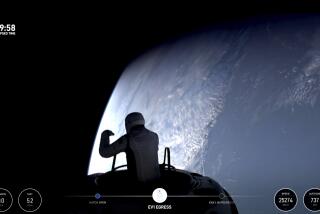Shuttle Sends Handymen for Spacewalk
- Share via
HOUSTON — Like a couple of weekend homebodies with a lengthy to-do list, two shuttle astronauts spent about seven hours in space Saturday tidying up and making household repairs to the International Space Station.
After days of worries about insulating tile damage, foam anomalies and other problems, day five of Discovery’s mission focused on the majesty of spaceflight and the workaday routine of cable and wiring repair.
“What a view,” Japanese astronaut Soichi Noguchi said as he stepped out of an airlock.
NASA spacewalk experts joked that the handrail outside the airlock was dented from astronauts hanging on for dear life at the sight of Earth revolving 220 miles below, inducing vertigo as if the astronauts were in a swaying kelp forest.
But Noguchi and his partner, Stephen Robinson, seemed to have no problems on their spacewalk, which lasted 6 hours and 50 minutes. In NASA terms, a spacewalk is known as “Extra-Vehicular Activity,” or EVA.
“We’re proud to welcome Steve and Soichi to the EVA hall of fame,” spacewalk manager Cindy Begley said, referring to a hallway at the Johnson Space Center in Houston lined with pictures of astronauts who have completed spacewalks.
Despite getting started an hour late, at 2:46 a.m. PDT, the spacewalkers accomplished everything they set out to do, and more.
The day began with the crew being awakened by a Japanese song called “Sanpo,” or “Strolling.” Two of Noguchi’s children were in the choir that sang.
“Thanks for the great chorus,” Noguchi said. “Today let’s go spacewalk.”
The two spacewalkers began in the shuttle cargo bay, testing methods to repair heat-resistant tiles and carbon reinforced panels. Discovery brought along several pre-damaged tiles and panels for the purpose.
Robinson used a device similar to a caulk gun to spread a material called NOAX on cracked panels, while Noguchi daubed a thinner “emittance wash” on the tiles.
“Both of them performed very well,” said N. Wayne Hale Jr., deputy shuttle program manager. “We’re very pleased. It’s one thing to do tests on the ground, but another thing in the real environment” of space.
Engineers won’t know for sure how well the substances worked until the crew returns to Earth and the repaired tiles can be examined.
After the tests, the astronauts affixed an attaching device for the External Stowage Platform, a kind of backyard toolshed that is to be installed on the space station during a spacewalk Wednesday.
Robinson worked to restore power to one of two faulty gyroscopes on the space station, an important job because four gyroscopes keep the station oriented and two have failed. A third has been performing spottily.
Robinson bypassed a faulty circuit breaker to get the device operating again. The other failed gyroscope is to be replaced on a spacewalk Monday with a new one brought from Earth.
Noguchi replaced a faulty global positioning antenna.
The maintenance work is especially important now that NASA has ordered a halt to future shuttle flights because a large piece of foam insulation fell off the external fuel tank two minutes into Discovery’s launch Tuesday.
Foam of about the same size hit the shuttle Columbia during launch in 2003, tearing a hole in the wing that ultimately caused the orbiter to break up on reentry. NASA engineers had spent the last two years and $1.4 billion redesigning the fuel tank so that no big foam chunks would fall.
NASA Administrator Michael Griffin said he wanted the shuttle fleet to return to operation as quickly as possible, but it could be months before the station had another visit from a shuttle crew.
In anticipation of a long delay, NASA extended Discovery’s mission a day, to 14 days, so that more food and equipment could be transferred to the station.
One of the last tasks performed Saturday was Noguchi’s trip to a spot outside the crew cabin, where he took pictures of a bit of insulation blanket that came loose and was sticking out of a window seal.
It was the latest glitch being studied by engineers assessing the damage that Discovery sustained during launch.
While Noguchi and Robinson were walking in space, pilot James Kelly maneuvered a robotic arm with laser cameras to take close-up scans of the delicate carbon reinforced panels on the leading edges of the left wing.
The camera revealed blemishes and scuffs on seven areas. NASA said the damage was “very minor.”
Hale said Saturday that engineers had evaluated and cleared 26 dings and divots found on the tiles covering 90% of Discovery.
That leaves two potential issues to resolve before Discovery gets the OK to fly home.
One is the blemishes on the panels on the wing leading edges. The second involves two gap fillers -- ceramic devices between tiles that act like caulking on bathroom tile -- that are sticking out 1.2 inches from the underside of the orbiter.
Even small protrusions can be dangerous at reentry speeds of Mach 20, but Hale said he felt increasingly confident that by Monday the orbiter would get final clearance to fly home.
Griffin said Friday that it appeared Discovery had suffered less tile damage than usual on a flight. Shuttles averaged 150 dings and divots on each of the previous 113 flights.
The comparison is not exact, however, because damage on other flights was measured after the orbiter’s return to Earth, and landing adds stresses.
Discovery is the first mission on which damage can be assessed during flight, because sensors and cameras were installed after the Columbia disaster.
More to Read
Sign up for Essential California
The most important California stories and recommendations in your inbox every morning.
You may occasionally receive promotional content from the Los Angeles Times.










